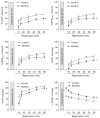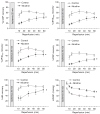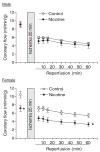Prenatal nicotine exposure increases heart susceptibility to ischemia/reperfusion injury in adult offspring
- PMID: 17947495
- PMCID: PMC2376745
- DOI: 10.1124/jpet.107.132175
Prenatal nicotine exposure increases heart susceptibility to ischemia/reperfusion injury in adult offspring
Abstract
In the present study we tested the hypothesis that prenatal nicotine exposure increases heart susceptibility to ischemia/reperfusion (I/R) injury in adult offspring. Nicotine was administered to pregnant rats via subcutaneous osmotic minipumps throughout gestation. Nicotine treatment resulted in a rapid and transient decrease in food-intake and a moderate decrease in maternal body weight gain. Hearts were isolated from adult male and female offspring and subjected to I/R in a Langendorff preparation. Nicotine significantly attenuated left ventricle (LV) developed pressure, heart rate, and coronary flow rate in female but not male hearts at baseline. Additionally, nicotine significantly increased LV infarct size and attenuated postischemic recovery of LV function in both male and female offspring with more pronounced effects in females. In female but not male hearts, nicotine significantly decreased the postischemic coronary flow rate. However, coronary nitric oxide release was decreased in male but not female hearts. Caspase-3, -8, and -9 levels were not significantly changed in either female or male hearts. However, nicotine caused a significant decrease in protein levels of protein kinase (PK) Cepsilon in both male and female hearts and a decrease in PKCdelta levels in female hearts only. Control studies of maternal food restriction showed that a moderate decrease in maternal body weight gain had no effect on female hearts but significantly improved postischemic recovery of LV function in male hearts. The results suggest that prenatal nicotine exposure causes in utero programming of the PKC isozyme gene expression pattern in the developing heart and increases heart susceptibility to I/R injury in adult offspring.
Figures










Similar articles
-
Prenatal cocaine exposure abolished ischemic preconditioning-induced protection in adult male rat hearts: role of PKCepsilon.Am J Physiol Heart Circ Physiol. 2009 May;296(5):H1566-76. doi: 10.1152/ajpheart.00898.2008. Epub 2009 Mar 13. Am J Physiol Heart Circ Physiol. 2009. PMID: 19286950 Free PMC article.
-
Prenatal hypoxia causes a sex-dependent increase in heart susceptibility to ischemia and reperfusion injury in adult male offspring: role of protein kinase C epsilon.J Pharmacol Exp Ther. 2009 Aug;330(2):624-32. doi: 10.1124/jpet.109.153239. Epub 2009 May 26. J Pharmacol Exp Ther. 2009. PMID: 19470841 Free PMC article.
-
Protective Effect of Antenatal Antioxidant on Nicotine-Induced Heart Ischemia-Sensitive Phenotype in Rat Offspring.PLoS One. 2016 Feb 26;11(2):e0150557. doi: 10.1371/journal.pone.0150557. eCollection 2016. PLoS One. 2016. PMID: 26918336 Free PMC article.
-
Prenatal cocaine exposure increases heart susceptibility to ischaemia-reperfusion injury in adult male but not female rats.J Physiol. 2005 May 15;565(Pt 1):149-58. doi: 10.1113/jphysiol.2005.082701. Epub 2005 Jan 27. J Physiol. 2005. PMID: 15677681 Free PMC article.
-
Effect of fetal hypoxia on heart susceptibility to ischemia and reperfusion injury in the adult rat.J Soc Gynecol Investig. 2003 Jul;10(5):265-74. doi: 10.1016/s1071-5576(03)00074-1. J Soc Gynecol Investig. 2003. PMID: 12853087
Cited by
-
Promoter methylation of Egr-1 site contributes to fetal hypoxia-mediated PKCε gene repression in the developing heart.Am J Physiol Regul Integr Comp Physiol. 2013 May 1;304(9):R683-9. doi: 10.1152/ajpregu.00461.2012. Epub 2013 Feb 20. Am J Physiol Regul Integr Comp Physiol. 2013. PMID: 23427086 Free PMC article.
-
Prenatal cocaine exposure abolished ischemic preconditioning-induced protection in adult male rat hearts: role of PKCepsilon.Am J Physiol Heart Circ Physiol. 2009 May;296(5):H1566-76. doi: 10.1152/ajpheart.00898.2008. Epub 2009 Mar 13. Am J Physiol Heart Circ Physiol. 2009. PMID: 19286950 Free PMC article.
-
Adverse effects of fetal exposure of electronic-cigarettes and high-fat diet on male neonatal hearts.Exp Mol Pathol. 2021 Feb;118:104573. doi: 10.1016/j.yexmp.2020.104573. Epub 2020 Nov 17. Exp Mol Pathol. 2021. PMID: 33212125 Free PMC article.
-
Prenatal Nicotine Exposure Raises Male Blood Pressure via FTO-Mediated NOX2/ROS Signaling.Hypertension. 2024 Feb;81(2):240-251. doi: 10.1161/HYPERTENSIONAHA.123.21766. Epub 2023 Oct 5. Hypertension. 2024. PMID: 37795601 Free PMC article.
-
The effect of fetal and neonatal nicotine exposure on renal development of AT(1) and AT(2) receptors.Reprod Toxicol. 2009 Apr;27(2):149-54. doi: 10.1016/j.reprotox.2009.01.012. Epub 2009 Feb 11. Reprod Toxicol. 2009. PMID: 19429393 Free PMC article.
References
-
- Bae S, Xiao Y, Li G, Casiano CA, Zhang L. Effect of maternal chronic hypoxic exposure during gestation on apoptosis in fetal rat heart. Am J Physiol. 2003;285:983–990. - PubMed
-
- Bae S, Zhang L. Gender differences in cardioprotection against ischemia/reperfusion injury in adult rat hearts. J Pharmacol Exp Ther. 2005b;315:1125–1135. - PubMed
-
- Barker DJ, Gluckman PD, Godfrey KM, Harding JE, Owens JA, Robinson JS. Fetal nutrition and cardiovascular disease in adult life. Lancet. 1993;341:938–941. - PubMed
Publication types
MeSH terms
Substances
Grants and funding
LinkOut - more resources
Full Text Sources
Research Materials

